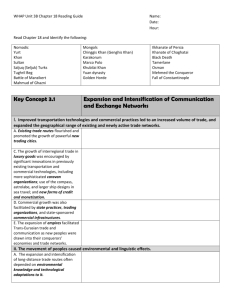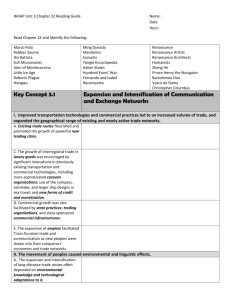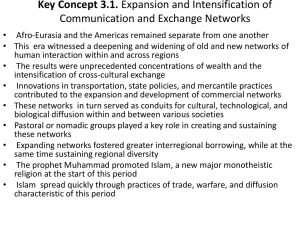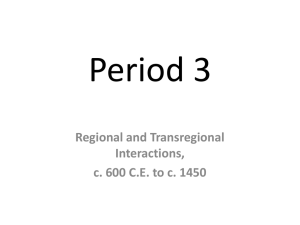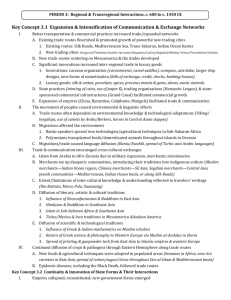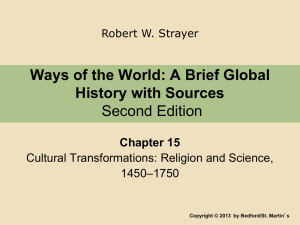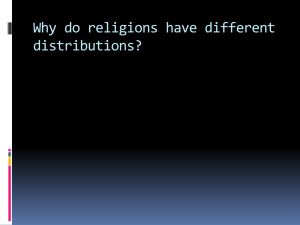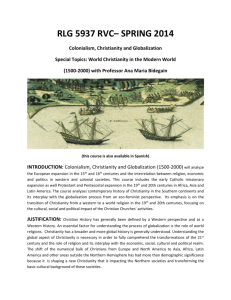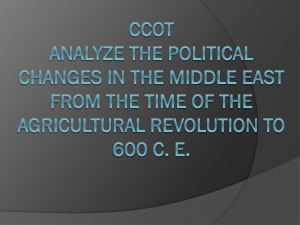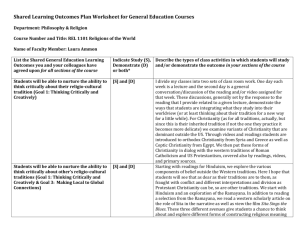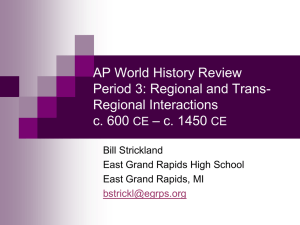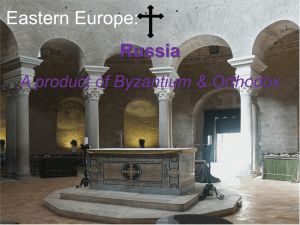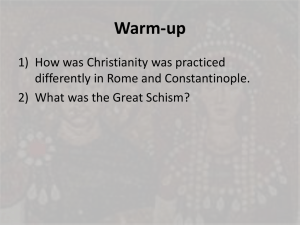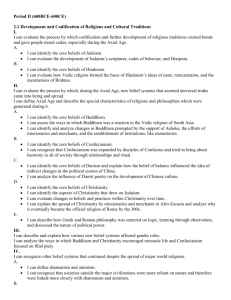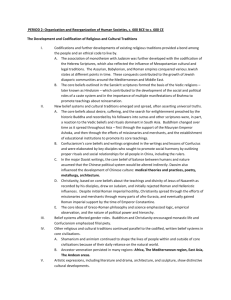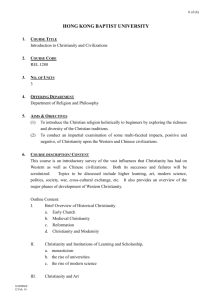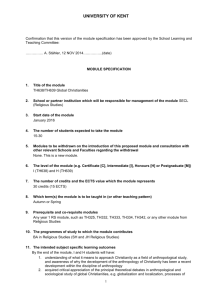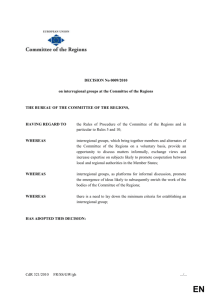WHAP Unit 3 Chapter 10 Reading Guide
advertisement
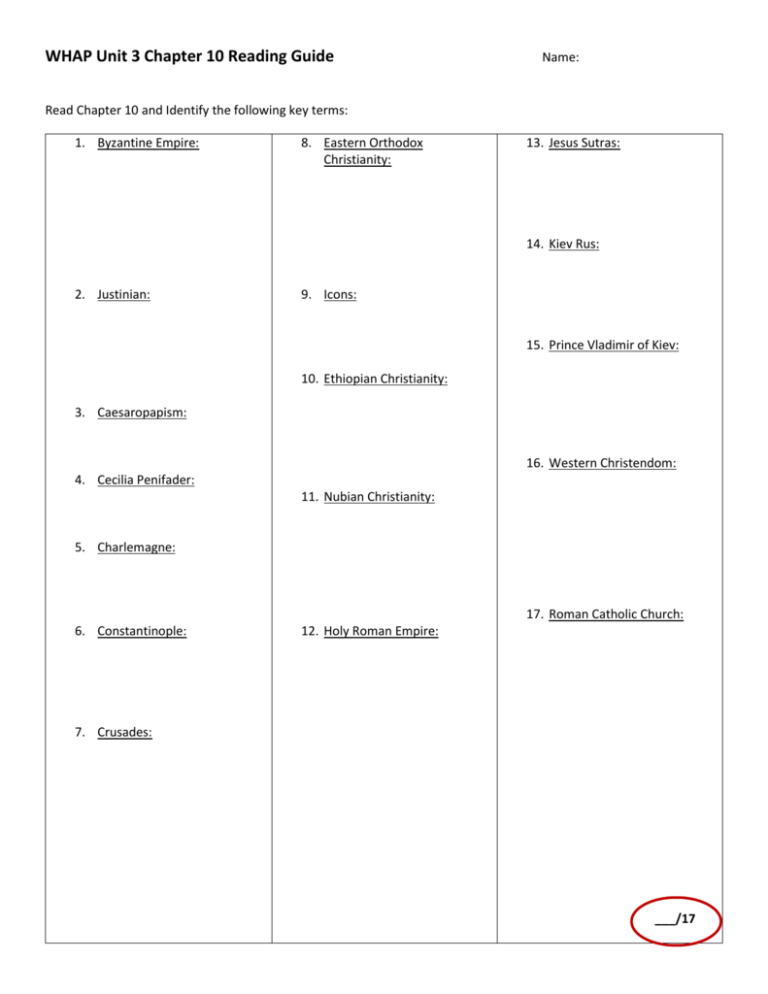
WHAP Unit 3 Chapter 10 Reading Guide Name: Read Chapter 10 and Identify the following key terms: 1. Byzantine Empire: 8. Eastern Orthodox Christianity: 13. Jesus Sutras: 14. Kiev Rus: 2. Justinian: 9. Icons: 15. Prince Vladimir of Kiev: 10. Ethiopian Christianity: 3. Caesaropapism: 16. Western Christendom: 4. Cecilia Penifader: 11. Nubian Christianity: 5. Charlemagne: 17. Roman Catholic Church: 6. Constantinople: 12. Holy Roman Empire: 7. Crusades: ___/17 Key Concept 3.1 Expansion and Intensification of Communication and Exchange Networks I. Improved transportation technologies and commercial practices led to an increased volume of trade, and expanded the geographical range of existing and newly active trade networks. A. Existing trade routes flourished and promoted the growth of powerful new trading cities. C. The growth of interregional trade in luxury goods was encouraged by significant innovations in previously existing transportation and commercial technologies, including more sophisticated caravan organizations; use of the compass, astrolabe, and larger ship designs in sea travel; and new forms of credit and monetization. D. Commercial growth was also facilitated by state practices, trading organizations, and state-sponsored commercial infrastructures. E. The expansion of empires facilitated Trans-Eurasian trade and communication as new peoples were drawn into their conquerors’ economies and trade networks. II. The movement of peoples caused environmental and linguistic effects. A. The expansion and intensification of long-distance trade routes often depended on environmental knowledge and technological adaptations to it. C. Some migrations and commercial contacts led to the diffusion of languages throughout a new region or the emergence of new languages. III. Cross cultural exchanges were fostered by the intensification of existing, or the creation of new, networks of trade and communication. A. Development and expansion of Islam B. In key places along important trade routes, merchants set up diasporic communities where they introduced their own cultural traditions into the indigenous culture. C. The writings of certain interregional travelers illustrate both the extent and the limitations of intercultural knowledge and understanding. D. Increased cross-cultural interactions resulted in the diffusion of literary, artistic, and cultural traditions. E. Increased cross-cultural interactions also resulted in the diffusion of scientific and technological traditions. IV. There was continued diffusion of crops and pathogens throughout the Eastern Hemisphere along the trade routes. A. New foods and agricultural techniques were adopted in populated areas. B. The spread of epidemic diseases, including the Black Death, followed the well-established paths of trade and military conquest. Key Concept 3.2 p.441 Continuity and Innovation of State Forms and Their Interactions I. Empires collapsed and were reconstituted; in some regions new state forms emerged. B. In some places, new forms of governance emerged; including those developed in various Islamic states, the Mongol Khanates, city-states, and decentralized government (feudalism) in Europe and Japan. C. Some states synthesized local and borrowed traditions. II. Interregional contacts and conflicts between states and empires encouraged significant technological and cultural transfers Key Concept 3.3 Increased Economic Productive Capacity and Its Consequences I. Innovations stimulated agricultural and industrial production in many regions. A. Agricultural production increased significantly due to technological innovations. B. In response to increasing demand in Afro-Eurasia for foreign luxury goods, crops were transported from their indigenous homelands to equivalent climates in other regions. II. The fate of cities varied greatly, with periods of significant decline, and with periods of increased urbanization buoyed by rising productivity and expanding trade networks. A. Multiple factors contributed to the declines of urban areas in this period. B. Multiple factors contributed to urban revival. C. While cities in general continued to play the roles they had played in the past as governmental, religious, and commercial centers, many older cities declined at the same time that numerous cities emerged to take on these established roles. Old: New: III. Despite significant continuities in social structures and in methods of production, there were also some important changes in labor management and in the effect of religious conversion on gender relations and family life. A. As in the previous period, there were many forms of labor organization. B. As in the previous period, social structures were shaped largely by class and caste hierarchies. Patriarchy persisted; however, in some areas, women exercised more power and influence. Social Class separations: D. The diffusion of Buddhism, Christianity, Islam, often led to significant changes in gender relations and family structure. Islam: Patriarchal structure: Christianity: Buddhism: ___/24 Ch 10 Big Questions: Must respond with 2-3 sentences. 1. What are and what caused the differences between the Byzantine Empire and Western European expressions of Christendom? 2. How did the Byzantium and Western Europe interact with each other and impact the larger world during the third wave of civilization? 3. How does the evolution of the Christian world during the third wave era compare to the development of the Tang and Song dynasty in China and the Islamic world in the Middle East? 4. What areas of Africa and Asia did Christianity spread? How did it affect these regions? 5. How did Roman Catholicism differ Eastern Orthodox Christianity? 6. How did links to Byzantium transform Kiev Rus? 7. What was the impact of the Crusades in world history? 8. In what ways did borrowing from distant cultures shape European civilizations? 9. In what different ways did classical Greek philosophy and science have an impact on the West, in Byzantium, and in the Islamic world? 10. How did class, family, and natural catastrophe shape Cecilia Penifader’s life? ___/10
